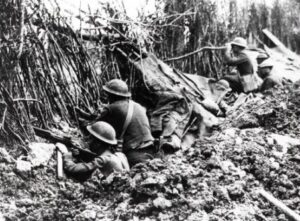
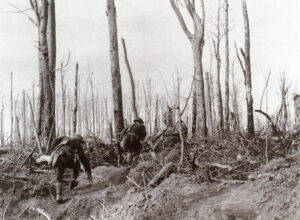 When I think of war and of the largest offensive in United States history, I don’t picture a battle in World War I. Nevertheless, I should. The Meuse–Argonne offensive, which was also called the Meuse River–Argonne Forest offensive, the Battles of the Meuse–Argonne, and the Meuse–Argonne campaign, depending on who you were, was a major part of the final Allied offensive of World War I that stretched along the entire Western Front. The offensive ran for a total of 47 days, from September 26, 1918, until the Armistice of November 11, 1918, and it was the largest in United States military history, past or present.
When I think of war and of the largest offensive in United States history, I don’t picture a battle in World War I. Nevertheless, I should. The Meuse–Argonne offensive, which was also called the Meuse River–Argonne Forest offensive, the Battles of the Meuse–Argonne, and the Meuse–Argonne campaign, depending on who you were, was a major part of the final Allied offensive of World War I that stretched along the entire Western Front. The offensive ran for a total of 47 days, from September 26, 1918, until the Armistice of November 11, 1918, and it was the largest in United States military history, past or present.
The offensive involved 1.2 million American soldiers, and as battles go, it is the second deadliest in American history. During the course of the battle, there were over 350,000 casualties including 28,000 German lives, 26,277 American lives, and an unknown number of French lives. The losses involving the United States were compounded by the inexperience of many of the troops, the tactics used during the early phases of the operation, and in no small way…the widespread onset of the global influenza outbreak called the “Spanish flu.” The 1918 Spanish Flu pandemic, also known as the Great Influenza epidemic, was an exceptionally deadly 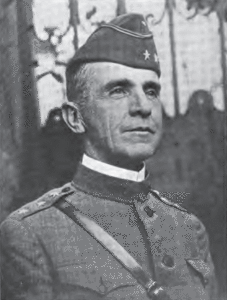
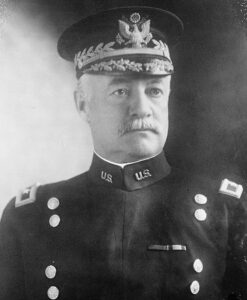 global influenza pandemic caused by the H1N1 influenza A virus. The pandemic affected an estimated 500 million people, or approximately a third of the global population. It is estimated that 17 to 50 million, and possibly as high as 100 million people lost their lives, which probably increased the deaths during the Meuse-Argonne offensive.
global influenza pandemic caused by the H1N1 influenza A virus. The pandemic affected an estimated 500 million people, or approximately a third of the global population. It is estimated that 17 to 50 million, and possibly as high as 100 million people lost their lives, which probably increased the deaths during the Meuse-Argonne offensive.
The Meuse–Argonne was the principal engagement of the American Expeditionary Force (AEF) during World War I, and it was what finally brought the war to an end. It was the largest and bloodiest operation of World War I for the AEF. Nevertheless, by October 31, the Americans had advanced 9.3 miles and had cleared the Argonne Forest. The French advanced 19 miles to the left of the Americans, reaching the Aisne River. The American forces split into two armies at this point. General Liggett led the First Army and advanced to the Carignan-Sedan-Mezieres Railroad. Lieutenant General Robert L Bullard led the Second Army and was directed to move eastward toward Metz. The two United States armies faced portions of 31 German divisions during this phase. The American troops captured German defenses at Buzancy, allowing French troops to cross the Aisne River. There, they rushed forward, capturing Le Chesne, also known as the Battle of Chesne (French: Bataille du Chesne).
In the final days, the French forces conquered the immediate objective, Sedan and its critical railroad hub in a 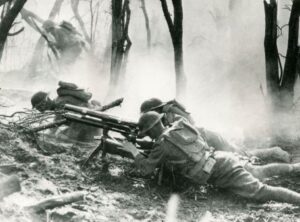

battle known as the Advance to the Meuse (French: Poussée vers la Meuse), and on November 6, American forces captured surrounding hills. On November 11, news of the German armistice put a sudden end to the fighting. That was fortunate for the armies, but for my 1st cousin twice removed, William Henry Davis, it was six days too late. He lost his life on November 5, 1918, on the west bank of the Meuse during these battles. He was just 30 years old at the time.

 Since time began, people have hoped for peace, and ended up in a battle. While “world peace” will likely never be an option, at least not in this world, governments continue to try, and those who oppose peace continue to do their best to sabotage the plans for peace. Israel has often been at the center of the battle for peace, which makes no logical sense. The other Arab nations have long been after the land, small as it is, that belongs to Israel. I never understood how they could covet the small piece of land that Israel had. The reality is that the Arab nations simply don’t want Israel to exist at all.
Since time began, people have hoped for peace, and ended up in a battle. While “world peace” will likely never be an option, at least not in this world, governments continue to try, and those who oppose peace continue to do their best to sabotage the plans for peace. Israel has often been at the center of the battle for peace, which makes no logical sense. The other Arab nations have long been after the land, small as it is, that belongs to Israel. I never understood how they could covet the small piece of land that Israel had. The reality is that the Arab nations simply don’t want Israel to exist at all.
In 1995, a rally was being held in support of the Oslo Accords at the Kings of Israel Square in Tel Aviv. A number of people had warned Yitzhak Rabin, the fifth prime minister of Israel, that his life could be in danger, but he would not back down. The Oslo Accords was a pair of agreements between Israel and the Palestine Liberation Organization (PLO). The Oslo I Accord was signed in Washington DC, in 1993. The Oslo II Accord was signed in Taba, Egypt, in 1995. The problem with these agreements is that the battle between these two groups goes so much deeper than just who owns the land. These nations are related and have been in a feud since the time of Jacob and Esau in Biblical days. Nevertheless, nations have tried to bring about peace between the two nations ever since the battle began.
On November 4, 1995 (12 Marcheshvan 5756 on the Hebrew calendar) at 9:30pm, at the end of the rally. An Israeli ultranationalist named Yigal Amir, who radically opposed Prime Minister Yitzhak Rabin’s peace initiative, and particularly the signing of the Oslo Accords, took it upon himself, to assassinate Yitzhak Rabin. The Likud leader and future prime minister, Benjamin Netanyahu, told Rabin’s government that withdrawing from any “Jewish” land was heresy, which I would have to agree with, because the land had been given to them by God. They believed that Rabin was probably too secular and too far removed from the Biblical Jewish tradition and Jewish values, but assassination is never the answer.
Conservative rabbis associated with the settlers’ movement prohibited territorial concessions to the Palestinians and forbade soldiers in the Israel Defense Forces from evacuating Jewish settlers under the accords. Some rabbis proclaimed “din rodef” based on a traditional Jewish law of self-defense, against Rabin personally, arguing that the Oslo Accords would endanger Jewish lives. The whole situation, which was “designed” to bring “peace,” took on a completely different tone…chaos. While I would never condone violence or assassination, I 
 don’t think Israel should ever be forced to give up parts of its land, and unfortunately, any peace agreement with the Palestinians always includes taking Israeli land, when Arab land is already far, far bigger. During the trial, Amir admitted to the assassination of Yitzhak Rabin and claimed that he was justified in doing so, saying that Amir he was “satisfied” and was acting on the “orders of God.” Following the trial, Amir was sentenced to life imprisonment for the murder of Rabin.
don’t think Israel should ever be forced to give up parts of its land, and unfortunately, any peace agreement with the Palestinians always includes taking Israeli land, when Arab land is already far, far bigger. During the trial, Amir admitted to the assassination of Yitzhak Rabin and claimed that he was justified in doing so, saying that Amir he was “satisfied” and was acting on the “orders of God.” Following the trial, Amir was sentenced to life imprisonment for the murder of Rabin.
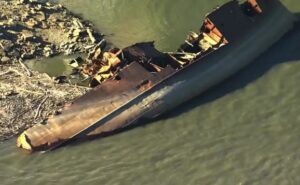
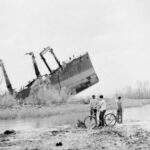 Some years are filled with rainy and snowy days, while others are drought filled, like this one. Each can have their consequences, if things go too far. As drought in the United States has progressed this past year, lakes and rivers have dried up, including the widest river…the great Mississippi River, which is not nearly as wide or as deep as it used to be. The reality is that suddenly, the Mississippi is bone-dry in some places. The average depth of the Mississippi River is normally 9 to 12 feet, with the deepest point being 200 feet. As with any river that is deep enough to run big boats or even little ones, invariably, there comes a sinking or two.
Some years are filled with rainy and snowy days, while others are drought filled, like this one. Each can have their consequences, if things go too far. As drought in the United States has progressed this past year, lakes and rivers have dried up, including the widest river…the great Mississippi River, which is not nearly as wide or as deep as it used to be. The reality is that suddenly, the Mississippi is bone-dry in some places. The average depth of the Mississippi River is normally 9 to 12 feet, with the deepest point being 200 feet. As with any river that is deep enough to run big boats or even little ones, invariably, there comes a sinking or two.
Sometimes, boats that sink can be recovered, and sometimes they can’t. The ship might be at a depth that makes it impossible, or the right equipment might not be available. Whatever the reason, in just about any body of water, there are bound to be a few mysterious finds hiding beneath the surface. As the Mississippi River has gone through the drought this year, there are the expected myriad of boats that are now stranded and languishing on dry land, but there are also a few surprises that are starting to appear. Some of the ships are old, but some are not as old, like the Diamond Lady, a casino boat that used to grace the mighty river. The Diamond Lady was christened in 1991, and was used in Iowa for a time, but in 2019, as things in Iowa got tough, the beautiful casino boat sailed south to an unknown fate in the mighty Mississippi River. The boat had been stored in Lake McKellar, but sank in 2021 during a freeze. Now it has resurfaced again. It’s not the oldest relic in the Mississippi River and the surrounding waterways, but it might have been the most majestic.
Unfortunately, there are sad finds in the river too. The drought has unearthed a sunken 19th-century shipwreck and human remains in the Mississippi River. I’m sure these won’t be the only human remains that suddenly surface, because while drowning victims are often found, there comes with a gambling a certain element that 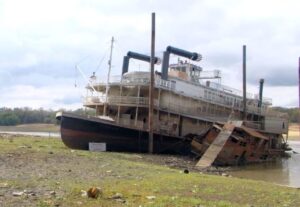
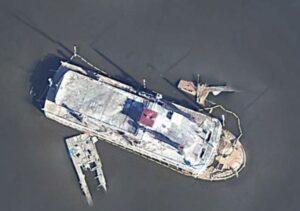 often brings the mysterious deaths, whether they are murders or just mysterious deaths whose cause cannot be determined. I’m sure there will be more ship, and possibly more bodies that turn up too. Then, before too long, the waters will return, and the mysteries will once again be hidden beneath the surface of the rivers and lakes.
often brings the mysterious deaths, whether they are murders or just mysterious deaths whose cause cannot be determined. I’m sure there will be more ship, and possibly more bodies that turn up too. Then, before too long, the waters will return, and the mysteries will once again be hidden beneath the surface of the rivers and lakes.
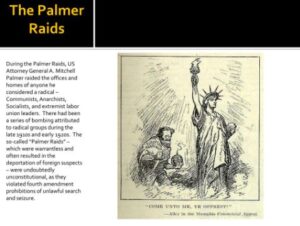 There has been a lot of talk in the news lately about Capitalism verses Socialism or Communism. Capitalism is clear-cut from the other ideologies, but the same cannot be said about communism and socialism. Socialism and communism are often used in place of each other despite being fundamentally different from each other. Capitalism puts the control of one’s assets in the hands of the individual, while socialism and communism put all or most assets in the hands of the government to hand out…or not…as they see fit. In my opinion, the government agencies we have really haven’t done such a great job that I would want to go back and give them more power and control.
There has been a lot of talk in the news lately about Capitalism verses Socialism or Communism. Capitalism is clear-cut from the other ideologies, but the same cannot be said about communism and socialism. Socialism and communism are often used in place of each other despite being fundamentally different from each other. Capitalism puts the control of one’s assets in the hands of the individual, while socialism and communism put all or most assets in the hands of the government to hand out…or not…as they see fit. In my opinion, the government agencies we have really haven’t done such a great job that I would want to go back and give them more power and control.
These days there are many people who would like to switch to Socialism or Communism, but I think it’s because they don’t understand these ideologies. The United States used to understand them very well, and when some of the immigrants tried to bring Socialism and Communism into this counter, in late 1919, and into January 1920, President Woodrow Wilson directed the United States Department of Justice to carry out a series of raids to capture, arrest, and deport these immigrants, because they should never be allowed to come to our 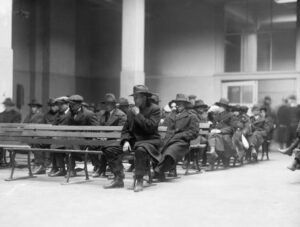 country and they try to change it in the country they chose to leave…especially because the reason they left was because it wasn’t working in their country.
country and they try to change it in the country they chose to leave…especially because the reason they left was because it wasn’t working in their country.
These raids were called the Palmer Raids. The primary targets were Italian immigrants and Eastern European Jewish immigrants with alleged leftist ties, with particular focus on Italian anarchists and immigrant leftist labor activists. Attorney General A Mitchell Palmer spearheaded the operation, and the result was that 3,000 people were arrested. Of the 3,000 arrested, 556 foreign citizens were deported, including a number of prominent leftist leaders.
As often happens in government, what one department likes another doesn’t, so Palmer’s efforts were largely frustrated by officials at the US Department of Labor, which had authority for deportations. They apparently objected to Palmer’s methods. The Palmer Raids during the time of the First Red Scare, a period of fear of and reaction against communists in the US in the years immediately following World War I and the Russian Revolution…the Cold War era. The Palmer Raids were strikes that garnered national attention, and prompted race riots in more than 30 cities, as well as two sets of bombings in April and June 1919, including one bomb mailed to Palmer’s home. Whether the methods were good or bad, I agree that no immigrants should ever 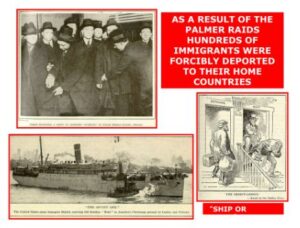 expect to come into this country and then fundamentally change how we run things until it becomes just like the nation that they worked so hard to escape.
expect to come into this country and then fundamentally change how we run things until it becomes just like the nation that they worked so hard to escape.
Unfortunately, Palmer’s raids became the subject of public criticism and led to the rise of the ACLU. Because very little evidence of terrorist bombs was uncovered during the raids, and people were held without legal representation, and some of the raids were carried out without search warrants, the whole operation took on a bad light, even if some of those who were arrested and deported were, in fact, terrorists.
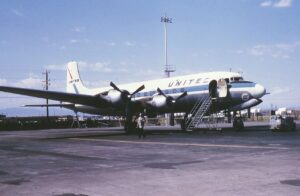 United Air Lines Flight 629, registration N37559, was a Douglas DC-6B aircraft also known as “Mainliner Denver.” The regular route for the flight was from New York City to Portland, Oregon, and then on to Seattle, Washington. This flight made one stop in Chicago and one in Denver. On November 1, 1955, United Airlines Flight 629 left New York City’s La Guardia Airport. It made a scheduled stop in Chicago before continuing to Denver’s Stapleton Airfield and landed at 6:11pm, eleven minutes late. Other than being eleven minutes late, the flight had been completely routine. The plane was refueled with 3,400 US gallons of fuel and had a crew replacement in Denver. Captain Lee Hall, aged 41, a World War II veteran, assumed command of the flight for the segments to Portland and Seattle.
United Air Lines Flight 629, registration N37559, was a Douglas DC-6B aircraft also known as “Mainliner Denver.” The regular route for the flight was from New York City to Portland, Oregon, and then on to Seattle, Washington. This flight made one stop in Chicago and one in Denver. On November 1, 1955, United Airlines Flight 629 left New York City’s La Guardia Airport. It made a scheduled stop in Chicago before continuing to Denver’s Stapleton Airfield and landed at 6:11pm, eleven minutes late. Other than being eleven minutes late, the flight had been completely routine. The plane was refueled with 3,400 US gallons of fuel and had a crew replacement in Denver. Captain Lee Hall, aged 41, a World War II veteran, assumed command of the flight for the segments to Portland and Seattle.
The flight departed Denver at 6:52pm. The flight’s last transmission came at 6:56pm, stating it was passing the Denver omni. Then, just seven minutes later, the air traffic controllers at Stapleton saw two bright lights suddenly appear in the sky north-northwest of the airport. Then, 30 to 45 seconds later, the lights fell to the ground at roughly the same speed…followed by a very bright flash originating at or near the ground. The flash was so intense that it lit up the base of the clouds 10,000 feet above the ground. The whole thing was quite strange, because there were no distress calls from aircraft in the area. They immediately contacted all aircraft flying in the area. The received responses from all the flights, except for Flight 629. The crash of Flight 629 killed all 39 passengers and five crew members.
There was nothing wrong with the plane. The pilots were not ill, nor were they insane. So, what could have brought down the plane? The initial investigation left the authorities stumped. The tail section had apparently been cleanly severed from the plane, almost as if it were cut off by a knife. The FBI consulted the Civil  Aeronautics Board (CAB) regarding the tail section. The eyewitnesses all said the same thing. They saw a fiery explosion in the air with flares streaming down and a second explosion on impact. That would also explain the two lights falling to the ground at about the same speed, but separately. It became very apparent that there had been an explosion mid-air, that actually caused the crash, but what caused the explosion.
Aeronautics Board (CAB) regarding the tail section. The eyewitnesses all said the same thing. They saw a fiery explosion in the air with flares streaming down and a second explosion on impact. That would also explain the two lights falling to the ground at about the same speed, but separately. It became very apparent that there had been an explosion mid-air, that actually caused the crash, but what caused the explosion.
The investigation focused on the luggage and a possible bomb. They looked at passengers with insurance. The focus moved to Denver locals, looking for personal enemies. One insured was local resident Daisie Eldora King, a 53-year-old Denver businesswoman who was traveling to Alaska to visit her daughter. They located her handbag and found a number of newspaper clippings containing information about King’s son, John Gilbert Graham, who had been arrested on a forgery charge in Denver in 1951. Graham was always bitter over his childhood. His mother had placed him in an orphanage as a child. Strangely, he alone was the beneficiary of both her life insurance policies and her will. Agents also discovered that one of Mrs King’s restaurants, the Crown-A Drive-In in Denver, had been badly damaged in an explosion. The suspicions were growing. Graham had insured the restaurant and then collected on the property insurance following the blast.
Agents searched Graham’s house and automobile. In the garage they found wire and other bomb making parts that were identical to those found in the wreckage. They also found an additional $37,500 ($379,300 today) in life insurance policies. The problem…Mrs King had not signed either these policies or those purchased at the airport, rendering them worthless. Graham denied putting a bomb in his mother’s luggage, saying she had packed it herself. His wife, Gloria contradicted his story, saying that Graham had wrapped a “present” for his 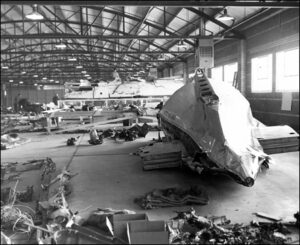 mother on the morning of Mrs King’s flight. Finally faced with mounting evidence against him, Graham admitted to having placed the bomb in his mother’s suitcase, telling the police on November 13, 1955, “I then wrapped about three or four feet of binding cord around the sack of dynamite to hold the dynamite sticks in place around the caps. The purpose of the two caps was in case one of the caps failed to function and ignite the dynamite … I placed the suitcase in the trunk of my car with another smaller suitcase…which my mother had packed to take with her on the trip.” The hatred and bitterness of one man, took the lives of 44 people, and destroyed the lives of their loved ones.
mother on the morning of Mrs King’s flight. Finally faced with mounting evidence against him, Graham admitted to having placed the bomb in his mother’s suitcase, telling the police on November 13, 1955, “I then wrapped about three or four feet of binding cord around the sack of dynamite to hold the dynamite sticks in place around the caps. The purpose of the two caps was in case one of the caps failed to function and ignite the dynamite … I placed the suitcase in the trunk of my car with another smaller suitcase…which my mother had packed to take with her on the trip.” The hatred and bitterness of one man, took the lives of 44 people, and destroyed the lives of their loved ones.
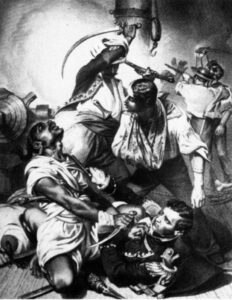
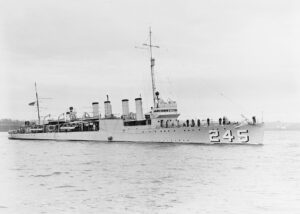 It is common practice in the military to name destroyers (DD) and destroyer Escorts (DE) after Navy and Marine Corps heroes. The USS Reuben James (DD-245) was a four-funnel (four stack) Clemson-class destroyer made after World War I, and it was the first of three US Navy ships named for Boatswain’s Mate Reuben James (1776–1838), who distinguished himself fighting in the First Barbary War. Apparently, on August 3, 1804, James put himself between his commanding officer, Lieutenant Stephen Decatur and the sword of a Tripolitan sailor, who was trying to defend his commander. When James stepped between the descending sword and his commander, he took the blow to his head. Amazingly, the blow did not kill him, and he recovered later to continue serving in the Navy.
It is common practice in the military to name destroyers (DD) and destroyer Escorts (DE) after Navy and Marine Corps heroes. The USS Reuben James (DD-245) was a four-funnel (four stack) Clemson-class destroyer made after World War I, and it was the first of three US Navy ships named for Boatswain’s Mate Reuben James (1776–1838), who distinguished himself fighting in the First Barbary War. Apparently, on August 3, 1804, James put himself between his commanding officer, Lieutenant Stephen Decatur and the sword of a Tripolitan sailor, who was trying to defend his commander. When James stepped between the descending sword and his commander, he took the blow to his head. Amazingly, the blow did not kill him, and he recovered later to continue serving in the Navy.
The Destroyer named after Boatswain’s Mate Reuben James, was the first sunk by hostile action in the European Theater of World War II. The USS Reuben James was laid down on April 2, 1919, by the New York Shipbuilding Corporation of Camden, New Jersey, launched on October 4, 1919, and commissioned on September 24, 1920. the ship was assigned to the Atlantic Fleet. Mainly, it was being used in the Mediterranean Sea during 1921–1922. The ship went from Newport, Rhode Island, on November 30, 1920, to Zelenika, Yugoslavia and arrived on December 18th. It operated in the Adriatic Sea and the Mediterranean out of Zelenika and Gruz (Dubrovnik), Yugoslavia, assisting refugees and participating in post-World War I investigations during the spring and summer of 1921. Then, it joined the protected cruiser Olympia at ceremonies marking the return of the Unknown Soldier to the United States in October 1921 at Le Havre. From October 29, 1921, to February 3, 1922, it assisted the American Relief Administration in its efforts to relieve hunger and misery at Danzig. After completing its tour of duty in the Mediterranean, it departed Gibraltar on July 17th.
Following its tour in the Mediterranean, the ship was based out of New York City, where it routinely patrolled the Nicaraguan coast to prevent the delivery of weapons to revolutionaries in early 1926. During the spring of 1929, it participated in fleet maneuvers that helped develop naval airpower. On January 20, 1931, the Reuben James was
decommissioned at Philadelphia, only to be recommissioned on March 9, 1932. The ship again operated in the Atlantic Ocean and the Caribbean Sea, patrolling Cuban waters during the coup by Fulgencio Batista. Then, in 1934, it was transferred to San Diego. After maneuvers that evaluated aircraft carriers, the Reuben James returned to the Atlantic Fleet in January 1939.
Upon the beginning of World War II in Europe in September 1939, but before the United States joined in the fight, the Reuben James was assigned to the Neutrality Patrol, guarding the Atlantic and Caribbean approaches to the American coast. The ship joined the force established to escort convoys sailing to Great Britain in March 1941. With U-Boat attacks on the rise, this force began escorting convoys as far as Iceland, after which the convoys became the responsibility of British escorts. At that time, it was based at Hvalfjordur, Iceland, commanded by Lieutenant Commander Heywood Lane Edwards.
It would be the escort post that would be the ship in the wrong place at the wrong time. On October 23rd, it sailed from Naval Station Argentia, Newfoundland, with four other destroyers, escorting eastbound Convoy HX 156. All seemed to be going well until, at dawn on October 31st, the Reuben James was torpedoed near Iceland by German U-Boat U-552 commanded by Kapitänleutnant Erich Topp. The Reuben James had positioned itself between an ammunition ship in the convoy and the known position of a German “wolfpack.” The “wolfpack” was a group of submarines poised to attack the convoy. Apparently, the destroyer was not flying the Ensign of the United States, that might have saved it…or maybe not, since it was in the process of dropping depth charges on another U-boat when U-552 engaged. The Reuben James was hit forward by a torpedo meant for a merchant ship and the torpedo blew the entire bow off when a magazine exploded upon the torpedoes impact. The bow of the Reuban James sank immediately. The aft section floated for five minutes before going down. I can only 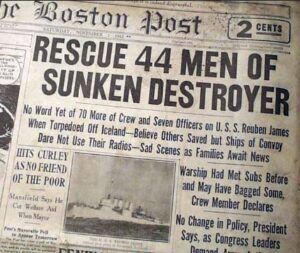
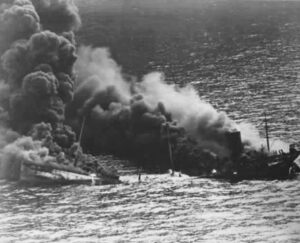 imagine the shock of those around them when the ship was gone so quickly. USS Reuben James carried a crew of seven officers and 136 enlisted men. They also had one enlisted passenger. Of the total of 144 men on board, 100 were killed, including all the officers. Only 44 enlisted men survived the attack. It was the first US warship sunk in World War II, and strangely, the destroyer was sunk before the United States had officially joined the war.
imagine the shock of those around them when the ship was gone so quickly. USS Reuben James carried a crew of seven officers and 136 enlisted men. They also had one enlisted passenger. Of the total of 144 men on board, 100 were killed, including all the officers. Only 44 enlisted men survived the attack. It was the first US warship sunk in World War II, and strangely, the destroyer was sunk before the United States had officially joined the war.

 My nephew, Matt Miller, is having a great year. Last year, on August 14th, Matt became a member of our family, when he married my niece, Michelle. With everything going on, and their prior wedding date having been postponed due to Covid, they decided to wait to take a honeymoon until this year. They wanted to let all the restrictions end before they took the most important trip of their married lives. So, for their first anniversary, they took their honeymoon trip to Saint Thomas, in the Virgin Islands. They have been honeymooning since they got married, so the trip was just the next step. They had a wonderful time on their trip. They snorkeled a lot and got to do something called SNUBA which is kind of like scuba diving, but you don’t have to train for it. They stayed at an all-inclusive resort, and they just loved it. They didn’t have to go anywhere or do anything they didn’t want to, they just relaxed, had fun, and had adventures.
My nephew, Matt Miller, is having a great year. Last year, on August 14th, Matt became a member of our family, when he married my niece, Michelle. With everything going on, and their prior wedding date having been postponed due to Covid, they decided to wait to take a honeymoon until this year. They wanted to let all the restrictions end before they took the most important trip of their married lives. So, for their first anniversary, they took their honeymoon trip to Saint Thomas, in the Virgin Islands. They have been honeymooning since they got married, so the trip was just the next step. They had a wonderful time on their trip. They snorkeled a lot and got to do something called SNUBA which is kind of like scuba diving, but you don’t have to train for it. They stayed at an all-inclusive resort, and they just loved it. They didn’t have to go anywhere or do anything they didn’t want to, they just relaxed, had fun, and had adventures.
They are both doing amazing at their jobs. Matt is a Production Supervisor at Peabody Energy at the North Antelope Rochelle Mine, and Michelle is an Art Educator at the Nicolaysen Art Museum. Their careers are really  taking off, and they are so excited to be doing the work they love. With their careers going well, they decided to start looking for a house, although with the market as bad as it is, it may not be the perfect time to do so. They aren’t in a huge hurry, so they are just checking to see what’s out there. They have a specific type of property in mind. They are hoping to find something with a couple acres of land because Matt has a lot of toys, so he needs a shop desperately. Men have to have their tinkering place.
taking off, and they are so excited to be doing the work they love. With their careers going well, they decided to start looking for a house, although with the market as bad as it is, it may not be the perfect time to do so. They aren’t in a huge hurry, so they are just checking to see what’s out there. They have a specific type of property in mind. They are hoping to find something with a couple acres of land because Matt has a lot of toys, so he needs a shop desperately. Men have to have their tinkering place.
Matt loves kids, and he is the best uncle to all of his nieces and nephew. He has three nieces, Hannah Miller, Elliott and Maya Stevens, as well as bonus niece and nephew, Brooklyn and Jaxon Killinger. The kids absolutely love their uncle, and he spoils them rotten…or so I’m told. I think he is just practicing for the children he and Michelle plan to have one of these days. They are very excited to have kids soon, and we all can’t wait either!! Babies are the most wonderful gift ever. For now, Matt is the best dog dad! They love and spoil their dogs, Obi and Leia…maybe, they say, a little more than some people would call normal, but I think they are like most pet 
 parents. Those dogs are their babies and will be even when the kids arrive. They are part of the family too.
parents. Those dogs are their babies and will be even when the kids arrive. They are part of the family too.
Matt did get a new “baby” this year…his new truck, and he is quite obsessed with it. this year that he is obsessed with it. Boys and their toys!! From trucks, to snowmobiles, to 4 wheelers, to motorcycles. It doesn’t matter what their toy of choice is. Boys will always be obsessed with their toys. Today is Matt’s birthday. Happy birthday Matt!! Have a great day!! We love you!!

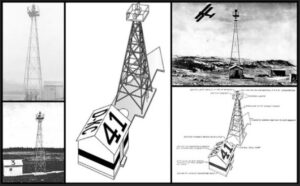 A number of years ago, I had the opportunity to go on a couple of business trips with my boss, Jim Stengel, in his plane. At that time, he introduced me to aviation charts, and I found them very interesting. You could see every airport on them, even the small private airports. You could also see every river, lake, and even pond, and they actually looked right on the map. I suppose the shapes would be off these days, due to droughts and such, but with GPS, I suppose they aren’t as necessary. Aviation charts could almost be considered a novelty now.
A number of years ago, I had the opportunity to go on a couple of business trips with my boss, Jim Stengel, in his plane. At that time, he introduced me to aviation charts, and I found them very interesting. You could see every airport on them, even the small private airports. You could also see every river, lake, and even pond, and they actually looked right on the map. I suppose the shapes would be off these days, due to droughts and such, but with GPS, I suppose they aren’t as necessary. Aviation charts could almost be considered a novelty now.
These days airmail is common, but on August 20, 1920, when the United States opened its first coast-to-coast airmail delivery route, we were just 60 years past the time when the Pony Express closed up shop. To me that is astounding…from horses to airplanes in just 60 years. When airmail got started, they didn’t have any of those aviation charts that had fascinated me on those flights with Jim. In those days, pilots had to navigate by sight…yikes!! Just imagine flying in bad weather, not to mention night flying, which was just about impossible. Some brainstorming was needed.
The Postal Service came up with a unique navigational system. The world’s first ground-based civilian navigation system was made up of a series of lighted beacons that extended from New York to San Francisco. I would think the pilots would have to be quite experienced to follow this plan. The plan included a series of 70-foot concrete arrows, placed ten miles apart from coast to coast. The arrows were painted bright yellow, and at the center of each arrow, stood a 51-foot steel tower. On top of the tower was a million-candlepower rotating beacon. Below the rotating light were two course lights pointing forward and backward along the arrow. The course lights flashed a code to identify the beacon’s number. A generator shed at the tail, or feather end of each arrow powered the beacon and lights, if that became necessary.
Like the railroad, the Airmail system was built in stages. By 1924, just a year after Congress funded it, the line of giant concrete markers stretched from Rock Springs, Wyoming to Cleveland, Ohio. The next summer, it reached all the way to New York and then, by 1929, it extended all the way to San Francisco. It worked so well, that in 1926, the new Aeronautics Branch in the Department of Commerce, now known as United States Postal Service, proposed a 650-mile air mail route linking Los Angeles to Salt Lake City. That route was designated as Contract Air Mail Route 4 (CAM-4). The system seemed well on its way to modernizing mail delivery forever, but
 before long, the advances in communication and navigation technology made the big arrows obsolete, as new technology will. By the 1940s, the Commerce Department decommissioned the beacons. To help the war effort, the steel towers were torn down and sent to be used elsewhere. Today, many of the arrows have been removed, but there are still a few that remain. I suppose if you spent some time scanning Google Earth, or flying along the old routes, you might be able to see a few of these old pieces of history.
before long, the advances in communication and navigation technology made the big arrows obsolete, as new technology will. By the 1940s, the Commerce Department decommissioned the beacons. To help the war effort, the steel towers were torn down and sent to be used elsewhere. Today, many of the arrows have been removed, but there are still a few that remain. I suppose if you spent some time scanning Google Earth, or flying along the old routes, you might be able to see a few of these old pieces of history.

 When Chris Kirk married my grandniece, Siara, he became my grandnephew. One of the things that Chris and Siara have in common is a love of exercise. They both work very hard at their fitness goals, and they love to work out together. I am amazed at how strong they both are. In fact, when they began dating, some of the first pictures we saw of the two of them working out together. I was amazed at the abilities of both of them. Chris works hard at the gym too, and he is always trying for personal bests and trying to be in power lifting contests.
When Chris Kirk married my grandniece, Siara, he became my grandnephew. One of the things that Chris and Siara have in common is a love of exercise. They both work very hard at their fitness goals, and they love to work out together. I am amazed at how strong they both are. In fact, when they began dating, some of the first pictures we saw of the two of them working out together. I was amazed at the abilities of both of them. Chris works hard at the gym too, and he is always trying for personal bests and trying to be in power lifting contests.
Chris is a hardworking man, who has moved up faster than anyone else who was hired at WL Plastics when he was. It is Chris’ goal to become a line operator, and he is moving quickly 
 toward that goal. His work ethic is great, and as we all know, lots of people these days want a paycheck, but don’t really want to work. That idea couldn’t be further from Chris’ mind. When he takes on a job, Chris gives it his all. He is loyal to the people he works for, and they appreciate that. I’m sure that is why he is moving up so quickly. He will make a great line operator very soon.
toward that goal. His work ethic is great, and as we all know, lots of people these days want a paycheck, but don’t really want to work. That idea couldn’t be further from Chris’ mind. When he takes on a job, Chris gives it his all. He is loyal to the people he works for, and they appreciate that. I’m sure that is why he is moving up so quickly. He will make a great line operator very soon.
When Siara lost her son, Alec Olsen, she was devastated, and after her first marriage broke up, she wasn’t sure she would ever get to be a mom again. Then Chris came along, and while they are not pregnant yet, Chris has wanted a family since he was 12 years old, so their goal to have a family is a common one for 
 them. In an unusual twist, Chris and Alec share a birthday. That is something that Siara finds very sweet. Her two loves, her husband and her son share a common bond even though they have never met…yet anyway. They will in Heaven, and I think they will love each other very much. Since today is both of Siara’s boys’ birthdays, they have decided to spend the weekend in Denver as a little celebration of the lives of both of them. I can’t wait for Chris and Siara to start a family. Chris is such a loving man, and he has been such a great blessing to Siara. I know he will be a great dad, when that day comes…just as he has been a great husband to Siara. Today is Chris’ birthday. Happy birthday Chris!! Have a great day!! We love you!!
them. In an unusual twist, Chris and Alec share a birthday. That is something that Siara finds very sweet. Her two loves, her husband and her son share a common bond even though they have never met…yet anyway. They will in Heaven, and I think they will love each other very much. Since today is both of Siara’s boys’ birthdays, they have decided to spend the weekend in Denver as a little celebration of the lives of both of them. I can’t wait for Chris and Siara to start a family. Chris is such a loving man, and he has been such a great blessing to Siara. I know he will be a great dad, when that day comes…just as he has been a great husband to Siara. Today is Chris’ birthday. Happy birthday Chris!! Have a great day!! We love you!!


